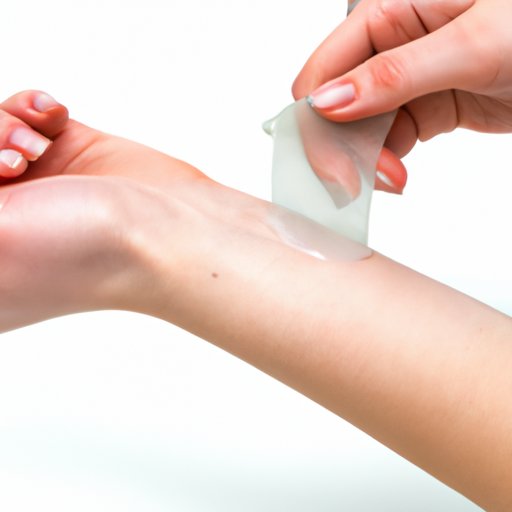Introduction
Calluses are thick, hardened layers of skin that develop in areas that experience continuous friction or pressure, typically on the hands or feet. Calluses can vary in size and color, from yellowish to grayish to brownish areas of skin. While normally not serious, they can be a nuisance and in some cases, require medical attention.
The development of calluses is usually due to footwear that is ill-fitting, or repeated use of instruments or tools that cause friction. In some cases, conditions such as diabetes can increase the risk of developing calluses. If left untreated, calluses can become painful and even lead to complications.
Home Remedies for Getting Rid of Calluses
If you have mild calluses, there are several home remedies you can try to soften and remove them. Here are a few:
Soaking calluses in warm water
Soaking your callused feet or hands in warm water for 10-15 minutes can help soften them and make them easier to remove. Adding Epsom salt can also help increase the effectiveness of the soak. Once the calluses have softened, gently rub them with a pumice stone.
Using a pumice stone
Using a pumice stone to gently rub calluses can help remove the hardened layer of skin. Before using the pumice stone, soak your feet or hands in warm water for at least 10 minutes to soften the calluses. Be sure to apply moisturizer after using the pumice stone to help keep the skin soft.
Applying natural oils or moisturizers
Applying natural oils or moisturizers can help keep the skin in the affected area soft. Soaking your feet or hands in warm water, followed by applying a moisturizer can help you achieve this. Some recommended natural oils for calluses include tea tree oil, coconut oil, or olive oil.
Over-the-Counter Products for Getting Rid of Calluses
If home remedies do not provide satisfactory results, there are several over-the-counter products that can help remove calluses. Here are two common products:
Callus pads
Callus pads can be placed onto the affected area to help reduce friction and pressure. These padding products come in various shapes and sizes and can be worn all day under socks or gloves.
Medicated creams
Medicated creams containing salicylic acid can help dissolve calluses and prevent them from returning. However, it is important to use them as directed and avoid applying them to healthy skin to prevent any adverse reactions.
Lifestyle Changes to Prevent Calluses
Preventing calluses is crucial in avoiding their development and minimizing their recurrence. Here are three lifestyle changes that can help prevent calluses:
Wearing comfortable shoes
Wearing comfortable, well-fitted shoes is key in reducing friction and pressure that causes calluses to form. Shoes that fit well and support your feet can distribute your weight more evenly and help reduce the formation of calluses.
Reducing friction
Reducing friction is important, particularly when using tools or performing repetitive activities that involve the hands. Methods of reducing friction can include changing the grip you use or using gloves or padding to help protect the skin.
Using protective gear
Using protective gear when engaging in sports or other activities that can put your hands or feet at risk can help prevent calluses. For example, wearing gloves when playing sports can help prevent calluses from forming on your hands.
Professional Treatment Options for Getting Rid of Calluses
If home remedies or over-the-counter products do not provide satisfactory results, it may be time to consider professional treatment options. Here are a few professional treatments for calluses:
Cryotherapy
Cryotherapy, or freezing, can be used to remove calluses. This treatment involves applying liquid nitrogen to the affected area to freeze the callus and then removing it with a scalpel.
Chemical peels
Chemical peels involve applying a solution to the callus that causes the skin to blister and peel off. While effective in removing calluses, this treatment can be painful and require a longer recovery time.
Surgery
In rare cases, surgery may be required to remove severe or recurring calluses. This procedure involves removing the affected skin and reshaping the bone underneath. Recovery time will depend on the extent of the surgery.
Tips for Ongoing Care to Prevent Calluses
Following these tips can help prevent the formation of calluses in the future:
Wearing specialized socks
Wearing socks that are designed to wick moisture away from the feet can help prevent the formation of calluses. These socks can help reduce the friction and pressure that leads to the development of calluses.
Using orthotics
Custom or over-the-counter orthotics can help distribute weight evenly across the feet, reducing the formation of calluses. Orthotics can also provide cushioning and support to the feet and prevent overpronation, which can contribute to callus formation.
Exfoliating and moisturizing regularly
Regularly exfoliating and moisturizing your skin can help keep your skin soft and prevent the formation of calluses. Gently exfoliating the skin with a pumice stone or foot scrub can help remove dead skin cells and prevent the development of calluses. Applying a moisturizer after exfoliating can help keep the skin soft.
Conclusion
Calluses are a common problem that can be easily managed using home remedies, over-the-counter products, or professional treatments. Preventing calluses through lifestyle changes is also crucial in avoiding their development and recurrence. Incorporating regular exfoliation and moisturizing into your personal care routine can help prevent the formation of calluses in the future.
